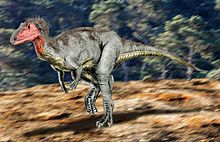Neovenator
Neovenator is a dinosaur classified in the Allosauroidea, a group within Carnosauria. It is from the Early Cretaceous (Barremian, 131 to 126 million years before present) Wessex Formation, and thus from the Wealden Group, a rock unit famous for its abundant dinosaur fauna. Its remains were discovered at Grange Chine, Isle of Wight (England). The only species is Neovenator salerii.
Like all Carnosauria, it was a bipedal carnivore. With a length of about 7.5 m, it was one of the largest predators of the Wealden fauna. Its prey probably included the ornithopod Iguanodon or sauropods. Another larger theropod from the Wealden fauna is the early Tyrannosaurus relative Eotyrannus lengi.
Neovenator was scientifically described in 1996 by Hutt, Martill and Barker. At the time of its description, it was the only confirmed allosauroid find from Europe. The name is composed of the Greek "neos" (new) and the Latin "venator" (hunter).
About 70% of the skeleton is known, making it one of the better known theropods. The front arms have not survived and only the front part of the skull is preserved. However, the most important features are found there: The nasal bone is huge, compared to other theropods, giving the skull a curious shape described as puffin-like. The premaxillae, unlike any other carnosaur (except Allosaurus), features five teeth. Overall, Neovenator was more lightly built than its relatives, such as Allosaurus.
Its systematic position within the Allosauroidae, which is divided into the families Sinraptoridae, Allosauridae and Carcharodontosauridae, is controversial. Mostly classified as Allosauridae, many researchers also consider it a primitive carcharodontosaurid. A closer relationship with the sinraptorids cannot be ruled out either.

Drawing of Neovenator
Questions and Answers
Q: What is Neovenator?
A: Neovenator is a dinosaur related to the clade which contains Allosaurus as its key member.
Q: Where was Neovenator discovered?
A: Neovenator was discovered on the Isle of Wight, UK.
Q: How long was Neovenator?
A: Neovenator was about 7.5 meters (24.5 feet) in length, but some fossils suggest a length of about 10 meters (33 feet), although these fossils are very fragmentary.
Q: What was Neovenator's weight?
A: Neovenator weighed 1000-2000 kg.
Q: When did Neovenator live?
A: Neovenator lived during the early Cretaceous, about 125 million years ago.
Q: What other dinosaurs did Neovenator exist alongside?
A: Neovenator existed alongside Baryonyx, Polacanthus and Iguanadon in the early Cretaceous.
Q: What pathologies did the holotype of Neovenator salerii have?
A: The holotype of Neovenator salerii had many pathologies, including midcaudal vertebrae fusions, healed fractures of mid-caudal vertebra transverse processes; osteophytes affecting pedal phalanges, healed gastralia rib fractures, some forming false joints, and scapula fracture. However, this means the individual survived and healed after a number of bone fractures.
Search within the encyclopedia